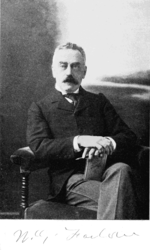William Gilson Farlow
| William Gilson Farlow | |
|---|---|
|
William Gilson Farlow | |
| Born |
December 17, 1844 Boston, Massachusetts |
| Died | June 3, 1919 (aged 74) |
| Nationality | American |
| Fields | Botany |
| Alma mater | Harvard |
William Gilson Farlow (December 17, 1844 – June 3, 1919) was an American botanist, born in Boston, Massachusetts, and educated at Harvard (A.B., 1866; M.D., 1870), where, after several years of European study, he became adjunct professor of botany in 1874 and professor of cryptogamic botany in 1879.[1]
Farlow corresponded with Caroline Bingham and Jacob Georg Agardh collaborating in the identification and classification of species of algae previously unknown to science.[2]
In 1899 he was president of the American Society of Naturalists; in 1904 president of the National Academy of Sciences; in 1905 president of the American Association for the Advancement of Science; and in 1911 president of the Botanical Society of America.
He received honorary degrees from Harvard University, the University of Glasgow (LL.D in 1901),[3] and the University of Wisconsin–Madison.
He was known as the "father" of cryptogamic botany in the United States.[4]
Among his publications are:
- The Gymnosporangia or Cedar-Apples of the United States (1880)
- Marine Algœ of New England (1881)
- A Provisional Host-Index of the Fungi of the United States (1888)
- Biographical Index of North American Fungi (1905)
-
 This article incorporates text from a publication now in the public domain: Gilman, D. C.; Thurston, H. T.; Colby, F. M., eds. (1905). "article name needed". New International Encyclopedia (1st ed.). New York: Dodd, Mead.
This article incorporates text from a publication now in the public domain: Gilman, D. C.; Thurston, H. T.; Colby, F. M., eds. (1905). "article name needed". New International Encyclopedia (1st ed.). New York: Dodd, Mead.
References
- ↑ Dupree, A. Hunter (1988). Asa Gray, American Botanist, Friend of Darwin. Baltimore, MD: Johns Hopkins University Press. p. 351. ISBN 978-0-801-83741-8.
- ↑ Setchell, W. A.; Dawson, E. Y. (1941). "Binghamia, the Alga, versus Bighamia, the Cactus.". Proceedings of the National Academy of Sciences of the United States of America. 27 (8): 376–381. doi:10.1073/pnas.27.8.376.
- ↑ "Glasgow University jubilee". The Times (36481). London. 14 June 1901. p. 10.
- ↑ Goodwin, Richard H. (2002). A Botanist's Window on the Twentieth Century. Harvard Forest, Petersham, Massachusetts, Harvard University. p. 9.
- ↑ IPNI. Farl.
